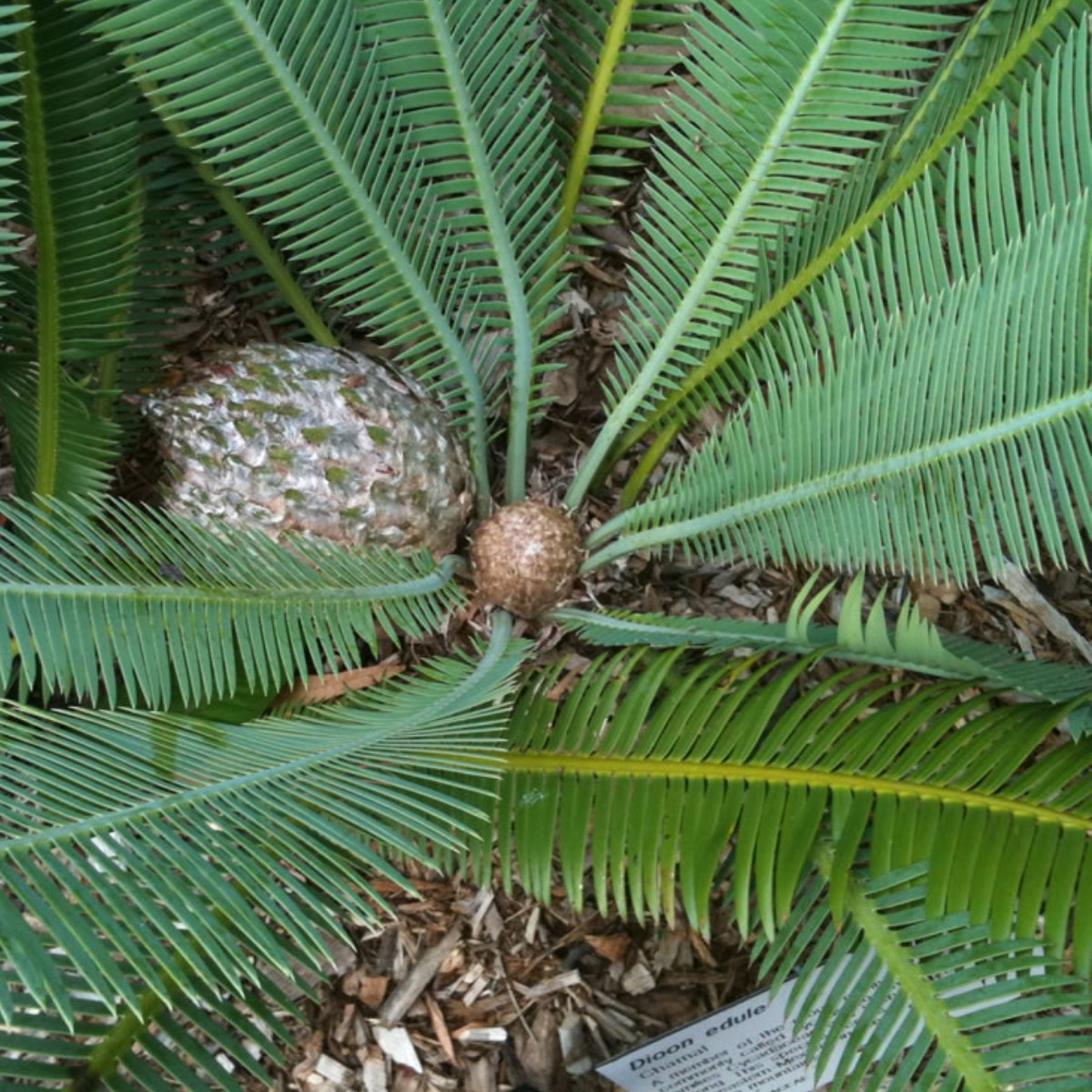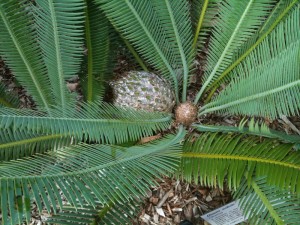Common name: Chestnut Dioon, Virgin's Palm, Mexican Cycad, Mexican Blue Chamal
Family: Zamiaceae
Synonymous: Dioon aculeatum
Dioon imbricatum
Dioon strobilaceum
Dioon strobilosum
Macrozamia littoralis
Macrozamia pectinata
Platyzamia rigida
Zamia maeleni
Zamia friderici-guilielmi
Zamia macleani
Zamia rigida
Distribution and habitat: Dioon edule is endemic to the eastern coast of Mexico. It commonly grows in tropical deciduous thorn forests and oak woodlands. They are usually found at an altitude between sea-level and 1500m (5000 feet) in harsh areas including exposed, shallow soils. Most of the areas in whichDioon edule grows are subjected to very dry climates and frequent brush fires which impact their survival and distribution.
Description: Dioon edule is a medium-sized Cycad with rather stiff, straight, light to blue-green leaves 100-200cm (39-78 inch) long which, as in all Cycads, are large and divided, giving the plant the appearance of a palm or tree-fern. Each leaf bears 70 to 150 pairs of narrow leaflets, which measure around 12cm (5 inch) in length and are sometimes slightly hairy. Opposing leaflets are arranged at 180 on rachis, not overlaping. The basal leaflets are reduced to spines. The petiole is spine-free for the first 5cm (2 inch) from the base. The trunk is made up mainly of storage tissue, with very little true wood and in this species may either stand erect or lie on the ground. This trunk is usually unbranched or sparsely branched and may reach 4m (13 feet) of height under optimal conditions and 20-50cm (8-20 inch) in diameter. Dioon edule specifically has the ability to contract its stem underground as it grows thus maintaining relativity in the amount of trunk exposed. As the plant gets older and grows a clump of taller trunk-stems, the leaf fronds are held more upright.
The Dioon edule are dioecious (presenting separate male and female plants) with a sex ratio distribution approximately 3:1 male/female. Male-gendered plants produce elongated woolly pollen cones, pale brown, 15-40cm (6-16 inch) long and 6-10cm (2.5-4 inch) diameter. Female cones are more egg-shaped, fuzzy, pale grey and very decorative, 20-35cm (8-14 inch) long and 12-20cm (5-8 inch) diameter. The seed cones entirely resemble a pineapple in form but the scales are feather-like and soft to the touch. A mature female cone may weigh 1-2kg and contain up to 200 or more seeds. The female cone cycle is approximately two years from initiation, pollination to dehiscence. Eventually the cone unravels to reveal nut sized seeds with a thin leathery skin. Seeds are ovoid, cream or white, 25-45mm long and 20-30mm wide.
Dioon eduleis the most widely cultivated species in this genus.
Gardening: The leaflets of Dioon edule taper to a sharp point. It is recommended to plant it away from footpaths and walkways. Wear heavy gloves when handling or working close to Dioon edule to avoid getting jabbed by the sharp points of the leaflets.
They are long lived and slow growing and a plant with 30cm (12 inch) of stem can be quite old (20-40 or more years). Dioon edule is considered easy to grow and a good choice for low-maintenance landscapes.
Position: Plant Dioon edule in sunny, well drained position in sub-tropical or temperate areas. It is light to moderate frost tolerant to about -12C (10F), but only for a short period of time (up to 4 days) and only when mature and well established plant. Dioon edule is one of the most cold hardy cycads.
They thrives and grows best in partial shade, especially in hotter climates.
Soil: They are very adaptable plants to just about any soil except muddy, non-draining clay. They prefer well drained, gritty soil with plenty of water, especially in dry weather.
Irrigation: In cultivation it prefers moist soil with good drainage for optimal growth. But they are eventually very drought resistant.
Watering during summer is beneficial and unimpeded air movement is important to avoid foliage being damaged by excessive wet.
Fertilising: Naturally undemanding for nutrients, Dioon edule responds very well to regular applications of fertilizer. Growth can be greatly improved through the application of fertilizers. Can be used slow release fertiliser to really kick them on. These plants will love a regular feed with liquid fertiliser, as it is both absorbed through the foliage and the soil.
Mulch well when plant them in the garden mulch conditions the soil, protects roots and saves water.
Containers: Dioon edule does well in containers and can be kept for many years in the same container. Being pot-bound does not usually affect they health adversely, but is does tend to slow its growth. Although container grown plants are unlikely to produce any seed.
Using Dioon edule in planters require same consideration given to container grown plants.
Light: Dioon edule can be kept indoors in a brightly lit spot or in a conservatory or greenhouse.
Temperature:Dioon edule makes a perfect specimen plant for the brighter conservatory or glasshouse, tolerating dry air, high temperatures, occasional light frosts and periods neglect if necessary. Slowly adjust them to full sun and keep them protected from frost and wind if possible.
Watering: During the active growth period water these plants moderately, enough to make the mixture moist throughout at each watering and allowing the top 5cm (2 inch) or so of the mixture to dry out before watering again. During any rest period that occur in cold season, give theDioon edule only enough water to prevent the potting mixture from drying out completely.
Please note that container grown plants will need more watering than plants in the ground.
Fertiliser: Applications of fertiliser should be made about every four weeks during the growing season.
Potting and repotting: Use a well draining potting mix. Can be added some sand, perlite or vermiculite to improve drainage or use a specific cacti & succulent potting mix. Repot these plants in containers one size larger in spring before the start of active growth only if needed. Do not choose a huge pot in the hope the plant will grow faster, as it would not. Most small plants will grow well in 8 or 10cm (3-4 inch) pots, medium plants will often be suited to 12 to 14cm (4.7-5.5 inch) pots, and large plants will need bigger pots to suit.
After repotting, water in the plants really well to get air bubbles out of the soil, as roots die when they come into contact with air bubbles. This might cause them to die back, prohibits them from thriving and might even cause death. It is one of the most important things to do when repotting these plants.
Propagation: Dioon edule can be propagated by fresh seed. It is among the easiest plants to germinate.
Dioon edule can be also propagated by division and replanting of the offesets grown at the base of mature plants.
Problems:
Dioon edule problems are usually related to stem and root rot which is usually caused by over-watering or by planting Cycads in soil that does not drain freely. This problem is easily circumvented by carefully choosing planting locations and by watering efficiently.
Scale insects are the most common pest.
Treatment: Look over the plant often for scale and treat any infestation immediately with insecticide.
Caterpillars may chew on the foliage.
Treatment: Use an adequate insecticide.
Notes: Dioon edule are rarely seen in gardens and are an endangered species. These 'living fossils' have been around since the time of the dinosaurs, although they are no longer as numerous as they once were.
Dioon edule can live to be 1,500 years old and eventually achieve a trunk height of 3m (10 feet), this medium-sized cycad is very slow-growing.
Toxicity: Since the skin of Dioon edule seeds is reportedly carcinogenic it is strongly advisable to use gloves when handling the seeds and caution against eating any parts of any Cycad!
Uses: Dioon edule can be used in many ways in a landscape. Large paired plants in containers or feature beds that flank driveways, doorways or gates. A single large specimen makes an excellent feature plant in a landscape that emulates a tropical or desert setting. Use Dioon edule to substitute for a true palm where a large crown is desired, but without a tall trunk. It can be a spectacular accent in a small garden where space is limited. It also makes an impressive understory to a larger tree or structure that allows at least partial sunlight to filter through. It is a perfect addition to accent a xeric landscape. Also it makes a beautiful specimen for large tubs or containers.
Height: 3m (10 feet)
Width: 0.7 - 1.7m (2-5.5 feet)
Hardiness zone: 8b-11
Begonia propagation f...
Essential Nutrients f...
Portulacaria afra
Tillandsia recurvata
Tillandsia stricta
Columnea microphylla
Clivia miniata
Cleyera japonica
Clerodendrum thomsoni...
Cleistocactus strausi...



